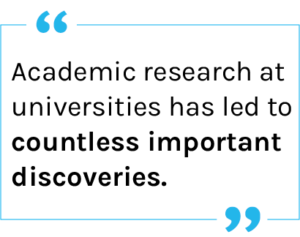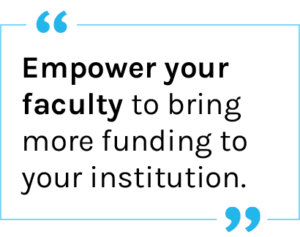Grants to fund faculty research are a vital part of keeping a higher education institution running.
Faculty research is a vital part of keeping a university competitive and driving institutional growth, and well-funded research  programs are also an important part of the learning experience for university students. But your institution doesn’t have an unlimited budget, so conducting research often requires grant funding, and getting funding requires grant applications. These applications take time — so how can you help remove administrative burden from faculty to free up their time and encourage more grant applications?
programs are also an important part of the learning experience for university students. But your institution doesn’t have an unlimited budget, so conducting research often requires grant funding, and getting funding requires grant applications. These applications take time — so how can you help remove administrative burden from faculty to free up their time and encourage more grant applications?
What do research and grants do for your university?
Faculty research has long been a central mission of many higher education institutions, especially at large research universities. Academic research at universities has led to countless important discoveries and wide-ranging inventions, from antibiotics to the Heimlich maneuver to the electric toothbrush. Such innovation is an important factor in economic growth and in social change.
 Beyond being part of your mission, research also serves other aspects of your institution. Research can make your faculty better teachers, or at the very least, keep them up-to-date and on the cutting edge of their fields. Engaging research occurring at your university also attracts graduate students and makes your institution more competitive.
Beyond being part of your mission, research also serves other aspects of your institution. Research can make your faculty better teachers, or at the very least, keep them up-to-date and on the cutting edge of their fields. Engaging research occurring at your university also attracts graduate students and makes your institution more competitive.
A great deal of academic research at many institutions is funded by grants. As higher education budgets come under even greater strain from budget cuts and falling tuition revenues, grant funding will only become more important for faculty to continue performing cutting-edge research.
Why do grant applications take so much time?
Unfortunately, a greater need for grant funding imposes a large time burden on your institution’s faculty. The application process for grant funding is competitive and it can be difficult for a faculty member to make their proposal stand out from the crowd. From searching for the right grant to refining research questions to writing a thorough application, the grant writing process is time-consuming – and most grants are rejected, so the process must be constantly repeated. A study at one teaching college showed that the largest obstacle for faculty seeking external funding was time. These time burdens include “continually preparing new classes every semester, heavy teaching loads, having a large class size, and having other administrative responsibilities.” Most grants also have unique requirements for information and formatting, meaning that the process of compiling data and formatting biosketches can take up precious time. Faculty often need to rework their CV or biosketch for each grant application, which is another barrier to applying for multiple grants.
How can you give time back to your faculty?
At most institutions, some faculty time burdens can’t be changed—like teaching and mentoring responsibilities. But administrative burden is one thing that your institution can reduce for faculty. A PeopleAdmin survey showed that 50% of higher education institutions are still using paper-based systems for faculty activity reporting, meaning that every time a faculty member is applying for a grant, they have to manually pull together all information about their past achievements, education and work history, and research projects. This work must be duplicated during tenure or promotion review, and for accreditation reporting. Such administrative work doesn’t have to be part of your faculty’s routine. PeopleAdmin’s Faculty Information System houses faculty information such as education history, work experience, professional contributions, publications, and research, keeping it up-to-date through real-time connections with ORCiD and other databases, allowing faculty to create custom-formatted biosketches at the click of a button. Digitization can reduce not only the time it takes for faculty to apply for grants, but also remove repetitive reporting work from faculty’s long to-do lists, encouraging them to spend that time instead on grant writing, research, and student mentoring. Empower your faculty to bring more funding to your institution.
contributions, publications, and research, keeping it up-to-date through real-time connections with ORCiD and other databases, allowing faculty to create custom-formatted biosketches at the click of a button. Digitization can reduce not only the time it takes for faculty to apply for grants, but also remove repetitive reporting work from faculty’s long to-do lists, encouraging them to spend that time instead on grant writing, research, and student mentoring. Empower your faculty to bring more funding to your institution.
Final Thoughts
Faculty research and, by extension, grant writing, are important to your institution’s success. If your institution’s systems can support faculty in gaining back time and simplifying grant applications, your institution will see the rewards in increased research and teaching. Supporting your faculty supports your institution and its mission. It’s time to digitize now!